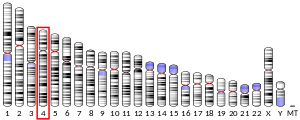Allregulin
| C4orf3 | |||||||||||||||||||||||||||||||||||||||||||||||||||
|---|---|---|---|---|---|---|---|---|---|---|---|---|---|---|---|---|---|---|---|---|---|---|---|---|---|---|---|---|---|---|---|---|---|---|---|---|---|---|---|---|---|---|---|---|---|---|---|---|---|---|---|
| Identifiers | |||||||||||||||||||||||||||||||||||||||||||||||||||
| Aliases | C4orf3, chromosome 4 open reading frame 3, HCVFTP1, ALN | ||||||||||||||||||||||||||||||||||||||||||||||||||
| External IDs | MGI: 1914954; HomoloGene: 88390; GeneCards: C4orf3; OMA:C4orf3 - orthologs | ||||||||||||||||||||||||||||||||||||||||||||||||||
| |||||||||||||||||||||||||||||||||||||||||||||||||||
| |||||||||||||||||||||||||||||||||||||||||||||||||||
| |||||||||||||||||||||||||||||||||||||||||||||||||||
| |||||||||||||||||||||||||||||||||||||||||||||||||||
| Wikidata | |||||||||||||||||||||||||||||||||||||||||||||||||||
| |||||||||||||||||||||||||||||||||||||||||||||||||||
Allregulin (ARLN) is a protein which in humans is encoded by the C4orf3 gene.[5] ARLN is a small ER transmembrane protein that regulates calcium homeostasis through SERCA (sarco-endoplasmic reticulum calcium ATPase). It is also known as C4orf3 and HCVFTP1 (hepatitis C virus F protein-transactivated protein 1).[6]
Gene
[edit]Chromosome 4 open reading frame 3 is a protein encoding gene that is located on chromosome 4 with specific location 4q26. It has a total of 3 exons.[6] The gene acts upstream or within negative regulation of ATPase-coupled calcium transmembrane transporter activity. The protein encoded by this gene is located in the endoplasmic reticulum membrane as an integral component. It is ubiquitously expressed in the esophagus, fat, and kidney.[6] It is a newly discovered tissue specific regulator of SERCA (sarco-endoplasmic reticulum calcium ATPase), its function to interact with the inhibitory groove of SERCA.[7]
mRNA
[edit]C4orf3 transcript variant 1 encodes for a mRNA sequence that is 2975 nucleotides in length. It is composed of three exons, two of which are embedded in the coding sequence and one that spans the rest of the sequence.[8] There is no 5’ UTR because the coding sequence begins at the beginning of the sequence and the 3’ UTR is 209 nucleotides long.[8]
Protein
[edit]ARLN is a small ER transmembrane protein that regulates calcium homeostasis through SERCA.[9] The molecular weight is 7.6 kDa. Isoform 1 is 199 amino acids long, however there is also a smaller isoform, that is 66 amino acids long.[8] The second isoform is the latter part of the first isoform. The protein and its orthologs are rich in arginine.[10] There is a transmembrane domain present near the C-terminus (amino acids 177-199).[11] This transmembrane domain is well conserved in orthologs.
Homology
[edit]
C4orf3 orthologs are found in most mammals, mainly in primates, but also in whales, dolphins, foxes and other mammals. There is one bird (Phalacrocorax carbo) where a C4orf3 ortholog is found. The C-terminus of the protein is highly conserved in these orthologs.
There are no human paralogs present for the gene.[12]
References
[edit]- ^ a b c GRCh38: Ensembl release 89: ENSG00000164096 – Ensembl, May 2017
- ^ a b c GRCm38: Ensembl release 89: ENSMUSG00000054091 – Ensembl, May 2017
- ^ "Human PubMed Reference:". National Center for Biotechnology Information, U.S. National Library of Medicine.
- ^ "Mouse PubMed Reference:". National Center for Biotechnology Information, U.S. National Library of Medicine.
- ^ "C4orf3 Gene - Chromosome 4 Open Reading Frame 3 - Gene Cards".
- ^ a b c "ARLN allregulin [Homo sapiens (human)] - Gene - NCBI". www.ncbi.nlm.nih.gov. Retrieved 2024-12-05.
- ^ Rathod N, Bak JJ, Primeau JO, Fisher ME, Espinoza-Fonseca LM, Lemieux MJ, Young HS (August 2021). "Nothing Regular about the Regulins: Distinct Functional Properties of SERCA Transmembrane Peptide Regulatory Subunits". International Journal of Molecular Sciences. 22 (16): 8891. doi:10.3390/ijms22168891. PMC 8396278. PMID 34445594.
- ^ a b c "Homo sapiens allregulin (ARLN), transcript variant 1, mRNA". NCBI. 2024-10-20.
- ^ Bon-Baret V, Chignon A, Boulanger MC, Li Z, Argaud D, Arsenault BJ, et al. (April 2021). "System Genetics Including Causal Inference Identify Immune Targets for Coronary Artery Disease and the Lifespan". Circulation. Genomic and Precision Medicine. 14 (2): e003196. doi:10.1161/CIRCGEN.120.003196. PMC 8284374. PMID 33625251.
- ^ "SAPS". www.ebi.ac.uk. Retrieved 2024-12-13.
- ^ "SOSUI: submit protein sequences". harrier.nagahama-i-bio.ac.jp. Retrieved 2024-12-05.
- ^ "EMBOSS Needle". www.ebi.ac.uk. Retrieved 2024-12-05.




